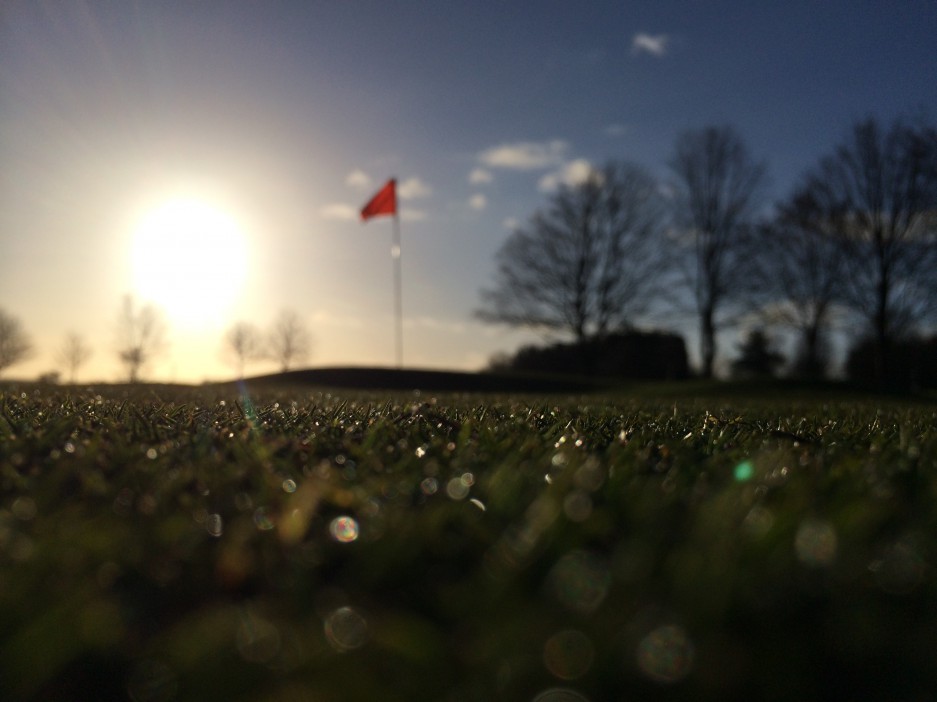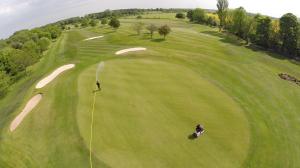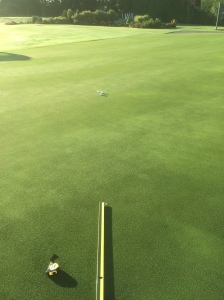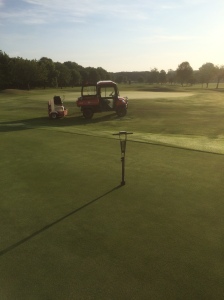This year we have taken a slightly different approach to producing the greens surfaces. There is no escaping the fact that we have had a horrible spring but let’s face it…. When do we ever not? With temperatures not allowing for any progression in terms of quality and heat/wind stress doing its best to kill off what we have, it has been a time for patience. Sanding when growth allows and applying minimal amounts of Nitrogen in accordance with Growth Potential. It has been a fine line between relieving drought stress and applying maintenance stress to keep the surfaces performing to their usual standards. A challenge the team has relished with good results.
With prolonged frosts restricting winter nutrition and a troublesome spring, by June our annual Nitrogen inputs were down 30% on last years. As long as the greens are still performing well this would normally be a good sign but with a small amount of Anthracnose(stress related turf disease) present on the 11th green and temperatures now allowing for larger N inputs we decided to apply a granular fertiliser.
Over the last 2-3years we’ve avoided applying a granular as it means applying a large amount of N, resulting in uncontrolled growth and inconsistent greens speeds. Instead we have opted for applying small amounts of N by spraying liquid feeds which gives more control over growth and greens speeds. There is no right or wrong way to apply N it’s more down to the preference of the team. The weeks following the application of the granular feed we have been applying a growth regulator at an increased rate to achieve more control of growth. As a result from the granular fertiliser the greens health is brilliant, so much so that we have reduced our current height of cut from 2.5mm to 2mm and reduced rolling frequency to maintain a greens speed between 10-11ft. Speeds have only exceeded this when the level of play dictates so, such as for league matches.
A possible downside of granular feeding is that late night greens speeds could have suffered from increase growth during the day. We have not had any feedback to suggest this but it should have been more noticeable than with liquid feeds. We are now back to applying liquid feeds and with growth back under control and still seeing the benefits of the granular. We have changed the N source to a slightly slower acting Nitrogen that is more heat tolerant. We can’t predict the weather but after a difficult spring it has completely fitted into our plan making it a success. As we stand we are currently 10% down on last years N inputs but managing a healthier sward. While the current weather is helping us catch up, every months average temperature so far this year has been less than last years. As we move forward we will continue to maintain the greens health with little and often N inputs. With the shift from increased rolling to a tighter height of cut to maintain greens speed this obviously leaves the option to fully open the sails up and reintroduce a increased rolling program at the lower height of cut, however we will monitor the need for this in accordance with members feedback.
I think it’s worth mentioning that at Ponteland we are currently enjoying a relatively easy period that has come to fruit from the commitment of trust the committee installed in the greenkeeping team. Not only that but producing the necessary funding and allowing us to grab the bull by the horns and carry out many aggressive techniques to rectify our thatch and drainage problems. It is very rare that a club has the funding, the trust and the ability to carry out necessary work from a committee and even more so in a village golf club like Ponteland. The memberships patience has also been key, putting up with 2 hollow cores and 2 passes with the Graden machine during the season. Then installing full drainage systems on 3 greens during the winter 2 and a half years running is extreme to say the least but, it has put us in a position where we no longer need to carry out major renovation works during Autumn/Spring so that come the Spring new growth contributes towards producing quality surfaces instead of aiding recovery. As long as the committee continue this support we will continue to enjoy success at Ponteland.
I hope I didn’t get too technical and you now have a fuller understanding of where we stand with the greens. If you have any questions then please leave a comment below.




Another right riveting read chaps! I’m particularly pleased to see that you feel trusted to crack on with what is clearly a very scientific+technical job. Well done again!!
Yes we certainly do and it’s the best way to see good results.